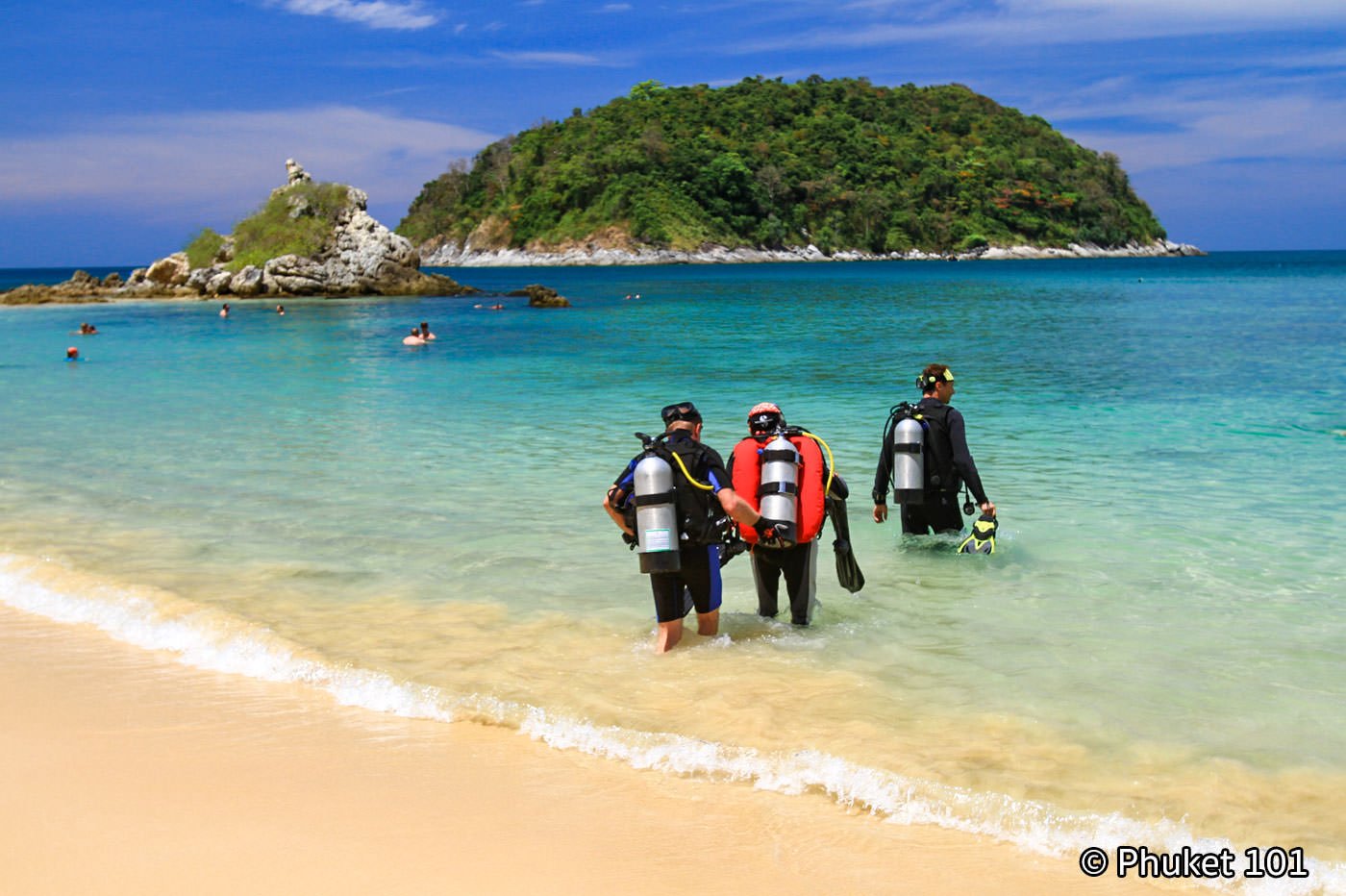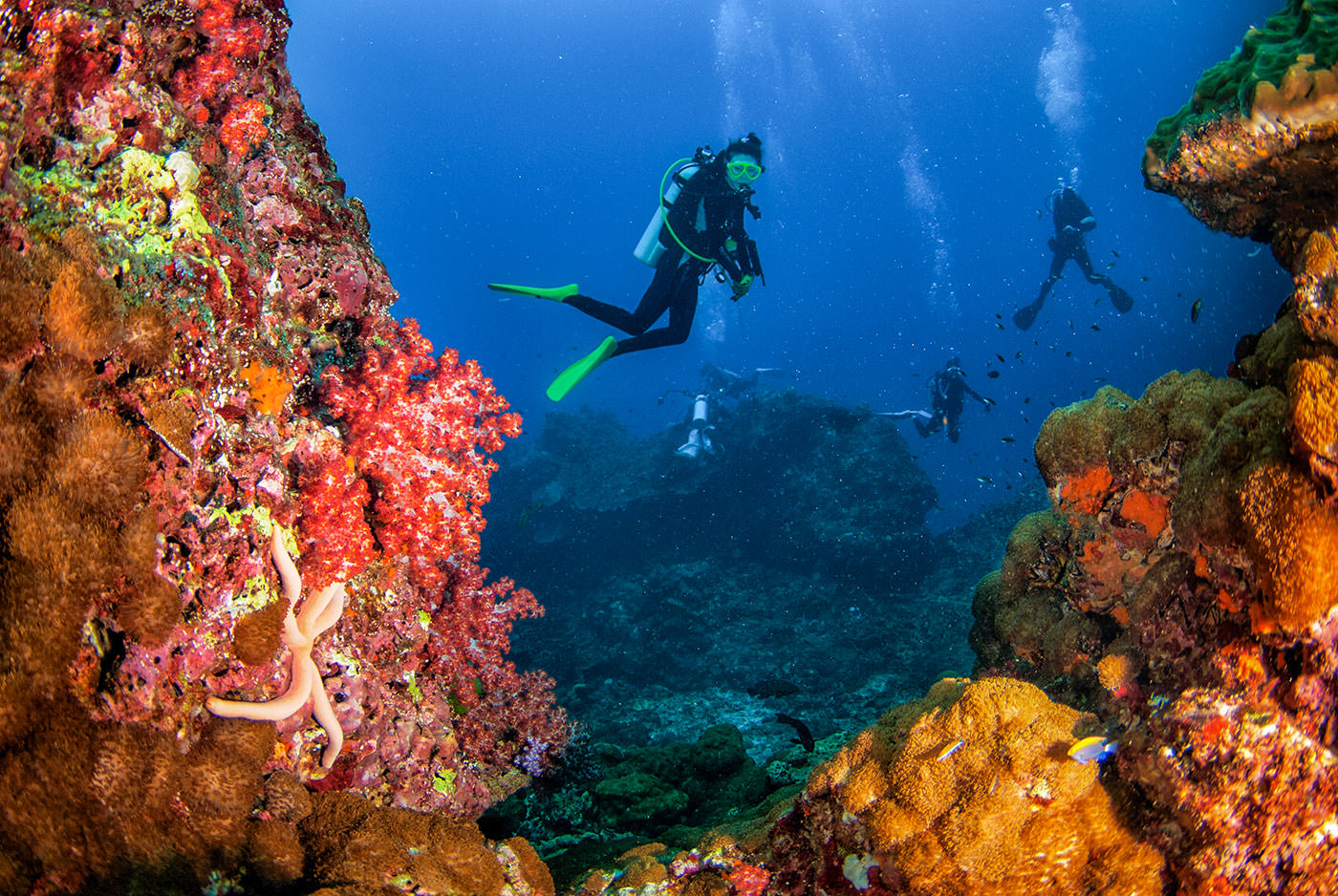Where are the best dive sites in Phuket?
What are the most popular dive sites in Phuket and around the island? Phuket is the gateway to diving in Thailand’s Andaman Sea, the jumping-off point for both northern and southern Andaman Sea dive sites. We have two weather patterns: the northeast monsoon from November to April and the southwest monsoon from May until October. The northeast monsoon is prime season for diving as all the marine national parks are open then, but Phuket offers year-round diving. The water is warm all year round, with temperatures averaging 29ºC or 84ºF.
Remember the diver’s mantra: Take only pictures, leave only bubbles.
Local Phuket Diving
Popular full-day dive trips near Phuket usually depart from Chalong Bay on the southeastern side of the island to sites both east and south of Phuket. The dive shop will pick you up from your hotel and return you there at the end of the day. Both two and three-tank dives are available every day.
1. Shore Diving

The Kata Beach shore dive on the south side of Kata Beach is popular with local diving schools for training as it’s an easy entry and a short swim to the reef. It’s also a very good way to get an idea of what diving in the Andaman Sea is like. It’s a great training area for beginners or those wanting a refresher before moving on to something more advanced. The coral is in good shape with many colours, and the marine life is rich and diverse. All the usual Indian Ocean fish species are here, and we get unusual nudibranchs, crabs and shrimp, and sand-dwelling animals. There are many moray eel species on the reef as well. You may even be lucky enough to find a frogfish or ghost pipefish. It makes a great easy night dive as well.
Maximum depth: 9 meters or 30 feet.
Difficulty level: Beginner.
Visibility: 5-10 meters.
2. Shark Point Area

The Shark Point area has several dive sites east of Phuket, on the way to the Phi Phi Islands. It takes about 90 minutes to get there by dive boat, and the trips depart every morning. Usually, the dive operator will offer two or three dives on the cluster of reefs surrounding Shark Point, including Anemone Reef, King Cruiser Wreck and Koh Dok Mai.
Shark Point itself is a pinnacle that juts out of the water at all tides and grows larger at its base. It’s covered with soft and hard corals, and when you look up, you’ll see clouds of fish. The rock is covered with marine life, including many species of moray eel, both large and small, lionfish, scorpion fish, and even frogfish if you’re lucky. Pipefish are easy to spot. There are beautiful, healthy sea fans to swim around. The name comes from our local shark favourites, the leopard or zebra shark, which sits at the bottom just breathing during the day and actively hunts at night. They have no teeth, they are not dangerous, and they are very approachable as long as you are slow and careful around them. Shark Point is probably the most popular dive site around Phuket.
Maximum depth: 21 meters or 70 feet.
Difficulty level: Intermediate.
Visibility: 5-20 meters.
3. The King Cruiser Wreck

The King Cruiser Wreck became a dive site in 1997 when this Phi Phi ferry sank after hitting Anemone Reef. No one was injured, and the boat took several hours to sink as one of its damaged pontoons filled up. Over the years, the Japanese ship has undergone lots of changes, with sections of the ship collapsing, including the wheelhouse some years ago. The ship is 85 meters in length with a beam of 25 meters. It used to rise up to 10 meters in depth, but with the collapse of the ship, the dive sites now begin at 18 meters. It’s a very nice dive site for both wreck and advanced diving courses and is popular with fun divers as it’s one of our deeper local dives. There are clouds of fish overhead, with a good growth of soft coral on her hull, and many species use the nooks and crannies of the wreck for protection from predators. You can still do a small penetration of the wreck from the stern.
Maximum depth: 33 meters or 110 feet.
Difficulty level: Advanced.
Visibility: 5-20 meters.
4. Anemone Reef

Anemone Reef lies just north of Shark Point and lies about five meters below the surface, making it a navigational hazard though easy to find with a map or GPS on board. The site is named for the thousands of anemones that cling to the rocky reef. It’s covered with large sea fans and lovely purple and soft pink corals making it one of the prettiest local dive sites we have. Currents are often strong here, so the boat drops you off near the pinnacle; you descend and stay close to the rock, checking the current before starting to explore. You’ll head down into the sand to look for leopard or zebra sharks which enjoy resting on the sandy bottom during the day. Then you’ll circle the pinnacle during the dive making a nice slow ascent to a safety stop them surfacing. There is something nice to see at any depth on this reef.
Maximum depth: 22 meters or 75 feet.
Difficulty level: Intermediate.
Visibility: 5-20 meters.
5. Koh Dok Mai

Koh Dok Mai, or “flower island” in Thai, is a mushroom-shaped limestone rock typical of the limestone karst formations we are famous for in the region. It’s a small round island which is easy to swim around in one dive. If the currents are mild, it’s easy to make two loops around the dive site. There are some submerged shallow caves in the rock, and it’s covered with soft corals and sea fans. It has the same marine life as the other dive sites in the area and is usually dived on the return journey back to Chalong Bay as the last dive of the day.
Maximum depth: 20 meters or 70 feet.
Difficulty level: Intermediate.
Visibility: 3-10 meters.
6. The Phi Phi Islands

Phi Phi is an archipelago of islands lying 30 nautical miles east of Phuket and is a popular holiday spot for divers as well as non-divers. It’s one of the most famous places in all of Thailand. While there are dive shops and hotels on the island of Phi Phi Don, the only way to see all the local dive sites around Phi Phi is by staying overnight on the islands and using local dive shops. If you’re coming from Phuket on a day trip, the two closest and best dive sites to Phuket are Koh Bida Nok (outside island) and Koh Bida Nai (inside island.) It takes about three hours to get to Phi Phi by dive boat, so two dives are really the maximum for the day. Local dive shops also visit these two dive sites.
Bida are two small limestone islands lying just next to each other, in fact, you can swim from one to the other if you have good air consumption. Normally they are done in two separate dives, with the surface interval taking place in a quiet cove where you can swim between dives. The limestone karst islands give you a pretty straight wall dive with the bottom at 30 meters (100 feet) or so. In the sand, you’ll find leopard sharks and small blue-spotted rays. The area attracts whale sharks and the occasional manta ray, so you’re warned to keep a good eye out for them. The sea fans are large and healthy, as are the soft corals. It’s a pretty good place for hard corals as well, which are healthy in deeper water. There are shallow caves to stick your head or body into. The dive sites are both very fishy, and anyone will be happy with the diving here.
Maximum depth: 30 meters or 100 feet.
Difficulty level: Beginner to intermediate.
Visibility: 10-30 meters.
7. The Racha Islands

Racha Yai and Racha Noi are islands directly south of Phuket, Racha Yai (Big Racha) is 12 nautical miles south of Phuket, and Racha Noi (Small Racha) is 20 nautical miles south of Phuket. Sometimes you’ll see Racha spelt as Raja or Raya. Racha Yai offers the best all-weather training sites around Phuket, so you’ll see many diving courses conducted here. Racha Noi is more advanced depending on the specific site. Both islands offer very good visibility year-round, with better visibility during the rainy season from May until October. There are several dive sites around both islands, so it’s fairly easy for the boats to spread out a little bit, and it’s easy to spend a full day here. For a more advanced day out, look for the three dive days; these usually include Racha Noi as well as Racha Yai. The bays on the island are gorgeous, with white sand beaches and clear blue water. The coral is in pretty good condition, and fish life is abundant. There are schools of snapper and barracuda, lionfish, and moray eels. You won’t see as many sea anemones here as compared to other sites.
Maximum depth: 21 meters or 70 feet.
Difficulty level: Beginner to intermediate.
Visibility: 10-40 meters.
Phuket Dive Site Map
John Williams has written, co-authored, or contributed to four diving guides on Thailand, the Mergui Archipelago, and the Andaman Islands. These are the award-winning Lonely Planet Diving & Snorkeling series, Periplus Editions Diving Southeast Asia, Asian Diver Scuba Guides and Singapore’s Times Edition Diving Thailand. He has lived in Phuket and has dived in Thailand’s waters since 1987.
